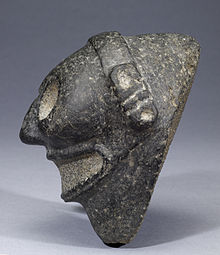
Taino Zemi Sculpture. Image retrieved from http://en.wikipedia.org/w/index.php?title=Ta%C3%ADno&oldid=651745566
The Taíno were a polytheist culture that worshipped and believed in more than one deity, or Zemi. The people held nature sacred and their two supreme deities were Yucahu (lord of cassava and the sea) and Atabey (his mother and goddess of fresh water and human fertility). There were also lesser deities, which took on many forms such as spirits of ancestors and spirits who lived in trees, rocks, and other landscape features. These spirits were related to life, creation, and death. The Taínos Behique (medicine person or Shaman) was the people’s connection between the human world and spirit world.
From the high peaks of the mountains to the river system, the islands were spiritual in every aspect. There are many versions of the Taíno creation story. The following version is one from the Classic Taíno and takes place on a mountain in present day Haiti. Myth has it that on a tall mountain there were two caves. The sun and the moon were kept in one cave, while the first people were in the other. One night, a demon who watched over the caves fell asleep, so the sun and moon escaped to the sky while the first people fled throughout the land. Yet, as they fled, some were turned into animals, trees, and birds by the light of the fun. The people continued to hold mountains and caves as sacred places, and gave thanks and honor by leaving gifts at these locations.

Zemí, a physical object housing a god, spirit, or ancestor. Image retrieved from http://en.wikipedia.org/w/index.php?title=Ta%C3%ADno&oldid=651745566
One of the most sacred locations is the Luquillo Mountain where two open-aired petro glyph sites held hundreds of people during public rituals. It is thought that the smaller private sites were possibly used for burial, ceremonies, or storage of shared resources. The Taíno believed in life after death, and the Caciques were buried with possessions and treasures, and at times accompanied by one or two spouses.
(Bauer et al., 2014; Rouse, 1992; Corbett, 2015; Jacobs, 1992; Corbett, 2015)
